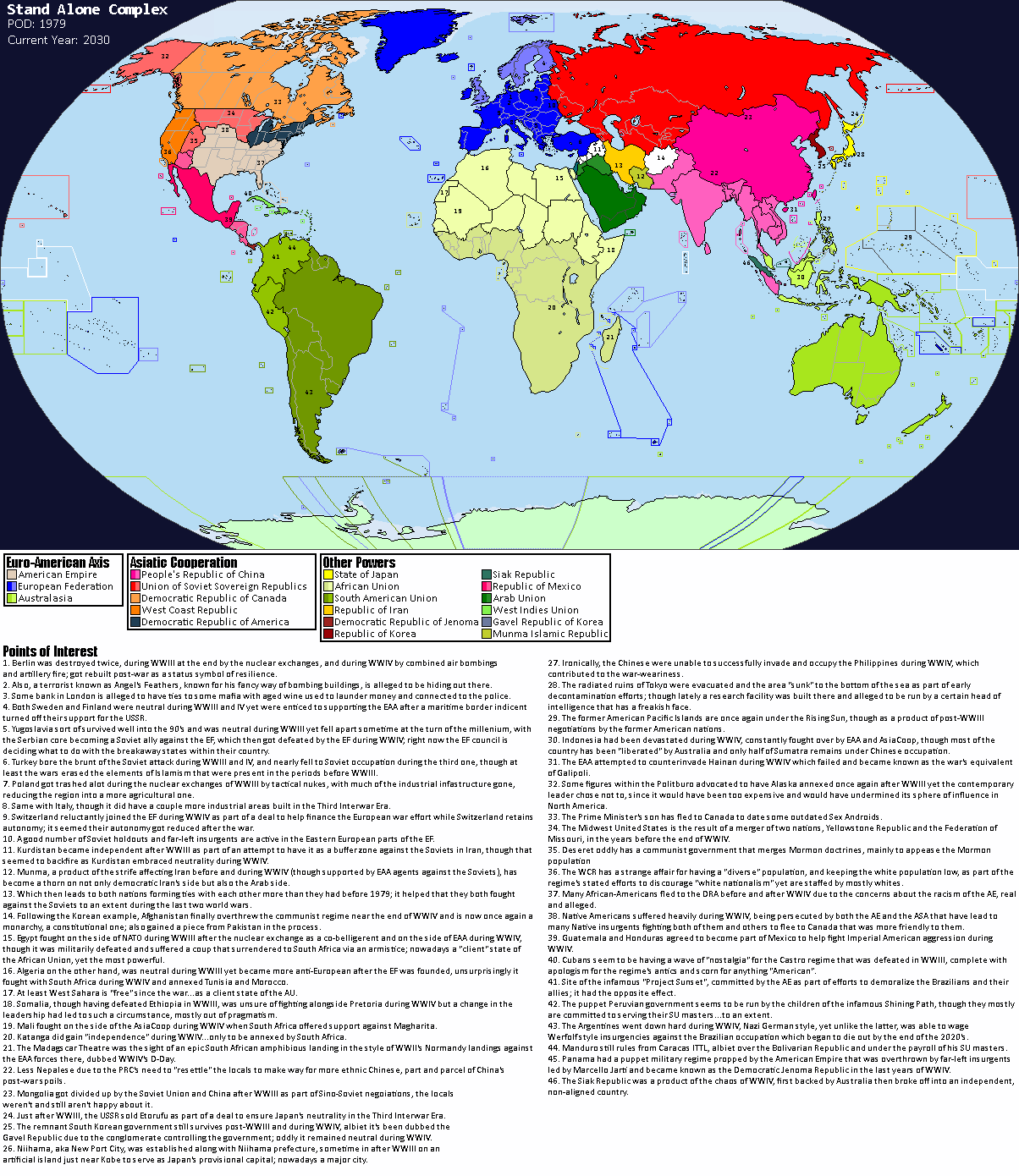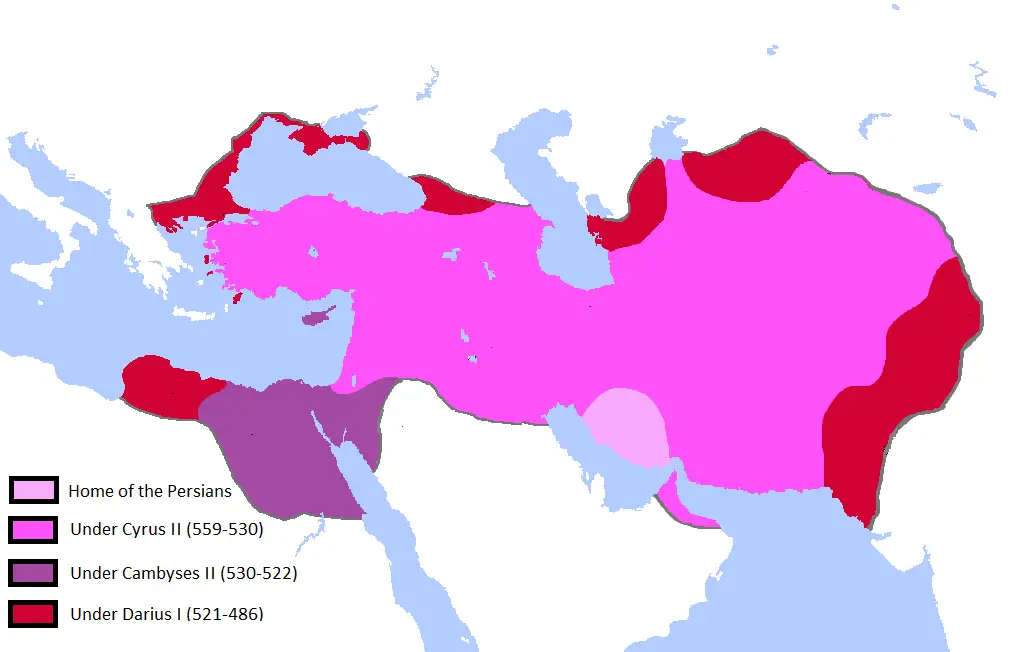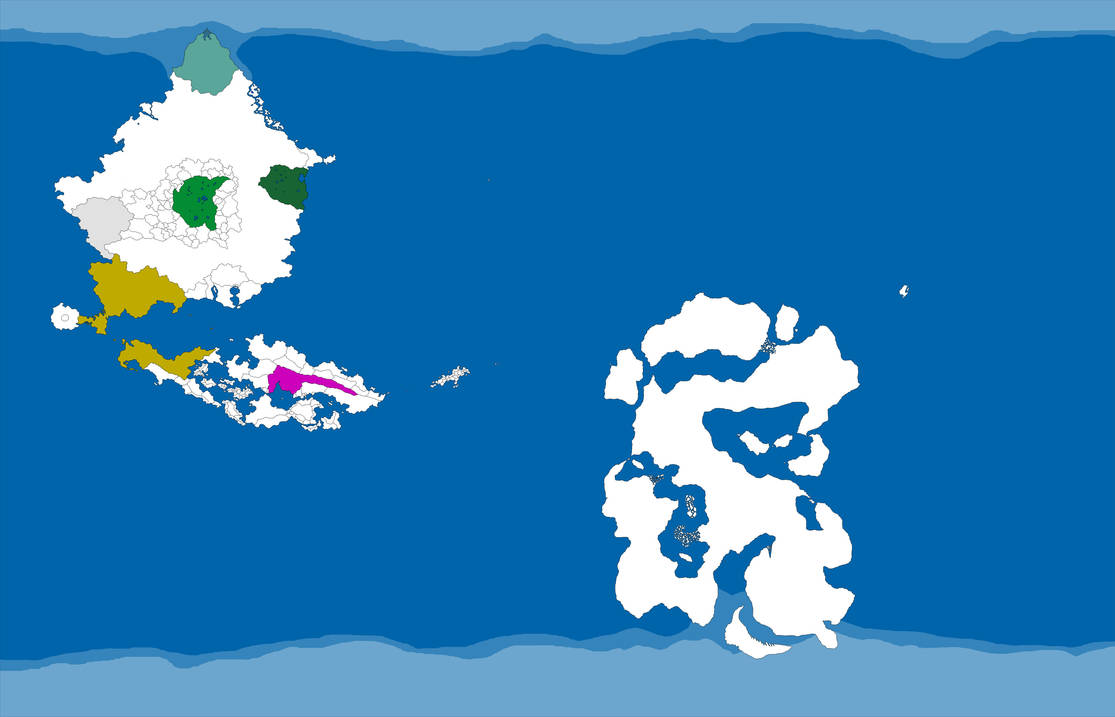Back into making maps and this time something to celebrate Ghost in the Shell's 30th anniversary, though admittedly I'm slightly late as the first manga began serialization in April 1989 rather than May (unless I'm mistaken of course). Basically a cover of the world of GITS, specifically the Stand Alone Complex incarnation, which really did fascinate for a while yet for this occasion, I'd figure I do something with it (it took me a while to conceptualize this since last year). Speaking of which, I used YNot1989's Americana map for ideas on the balkanized USA part, though I did take some liberties from the source material to make this sound "plausible", with some ideas from Appleseed which amusingly enough is "canon" to GITS.

The POD is the Soviet Premier Leonid Brezhnev kicking the bucket in September 1979, just after the President of Afghanistan, Nur Muhammed Taraki, was disposed by Hafizullah Amin. His successor, Yuri Andropov, takes over and tells Amin that the instability is his own issue and not the USSR's (though Taraki was still assassinated), thus butterflying away the Soviet invasion of Afghanistan and continuing Détente well into the late 20th century. US President and Democrat, Jimmy Carter is re-elected in 1980 despite the Eagle Claw operation failing just like OTL's, thus continuing his softline policy towards the Eastern bloc (though he does often bring up the human rights abuses occurring there) and improving the US economy with some leftwing ideals in contrast to Reagan's neo-liberal ones of OTL. Andropov's rule, sees the USSR adopting some necessary economic and in some cases, social reforms, improve the country, and encourages the Warsaw Pact to do the same, of which they did to an extent (though Poland still had the Solidarity protests occur), though they all remain just as Communist as they were IOTL (though their commitment to the ideology varied), with the Berlin Wall still standing beyond 1989. The SALT treaties continue to be signed, with each one reducing the nuclear weapons arsenals of both blocs more so than OTL's.
Détente between the Western and Eastern blocs would still continue with Democrat Dukakis being elected in 1988 and keeping his predecessor's policy going. Andropov would die in 1991 to health problems, being succeeded by Konstantin Chernenko, who despite having some hardline stances akin to Brezhnev's, continued his predecessor's policies. Though, the PRC has somewhat sided with the USSR more often due to the Tiananmen Spring massacre turning off the West and a peaceful resolution to the Sino-Vietnamese tensions. Seemingly, the tension between the blocs might fade away by the arrival of the 21st century, according to some politically minded people, though a twist of fate would change that, with a powder keg would being lit in Syria.
Just before, Ba'athist Iraq got away with invading Kuwait in 1990 instead of being ousted like OTL's (due to the US administration reluctant to confront an aggressive power which cost Dukakis a chance for re-election in 1992, losing to Republican Dan Quayle) and sought to expand its sphere of influence around the Arab world, starting with its old rival, Syria. A coup by pro-Iraqi officers in the early 1990's that disposed the Assad regime, brought in Ba'athist "advisors", many of which were heavily armed, concerning both Israel, Turkey, and Saudi Arabia (though the latter was reluctant to confront its fellow Arab nation). In 1994, Israel would launch airstrikes against the pro-Iraqi forces in Syria leading to the Iraqis launching Scuds in retaliation, only to be responded with a few nuclear missiles being fired at key Iraqi cities, with Baghdad being destroyed in the process. The whole war in Syria would escalate further with not only the Arab world cutting off diplomatic ties (even Egypt did this) with Israel, but also Islamist Iran (being a technical US ally despite having a hardline Islamic fundamentalist stance) invading Iraq, leading to the Soviet Union cutting diplomatic ties with Tehran in 1995 and sending "volunteer" forces in Syria to aid the Iraqis and later having its own pre-emptive airstrikes against Tel-Aviv in the spring (though avoiding the use of and targeting nuclear weapons). The Western bloc was outraged at the Soviets committing aggression and worsening the Syria War and cut diplomatic ties with Moscow and the WP, sent aid and "advisors" to Israel, and declaring war on Ba'athist Iraq in the summer. The Politburo threatened war against NATO if they did not step down from backing Israel to the point of cutting off West Berlin, yet NATO did not back down, thinking it was yet another Khrushchev-esque bluff, only this time it wasn't a bluff. In October, the Warpact made its move in the night, attacking key NATO positions and taking over West Berlin (almost bloodlessly), starting World War III.
The conflict, just like pre-war speculation by figures like Sir John Hackett, starts out conventionally, with both sides aware of potential nuclear escalation (though Israeli proved to be a wildcard), and thus stuck to the old-fashioned ways of not-using nukes, at least for a while. The Warpact was able to overrun most of West Germany along with taking over Austria, Greece, Turkey, and Denmark by November, running into a stalemate along the Rhine (the French policy on using nukes in the event of the WP crossing over still stands), yet are making inroads in Norway and Syria. Iran was being invaded by the USSR in the process, though it has run into a stalemate thanks to Iranian resistance on both the battlefield and by guerillas. Latin America and Africa would be pulled in, with Cuba and Apartheid South Africa fighting for their respective allies. Asia would also be affected to an extent, with China attacking and invading Taiwan and Japan declaring war to support NATO, the Korean peninsula would also be embroiled as both North and the South would fight each other.
As the early winter of 1996 has arrived, the nuclear genie would again be let out of the bottle when Israeli high command authorized nuclear strikes on the WP forces in Syria nearing the Golan Heights. The attack would sent a shockwave to the Soviet High Command, leading to the Politburo's decision to attack NATO with strategic nuclear weapons immediately, starting with the US. In January, the first wave of nuclear weapons hit key US cities and bases, including the capital (though the Quayle administration had been evacuated secretly beforehand), only for the US (along with the UK and France) to retaliate with similar strikes on key Soviet cities and bases (though they were less of them due to the Soviet nuclear strikes taking out some of their missile bases). China contributed to the fire with nuclear attacks on the USA and Japan, the latter of which contributed to it's withdrawal from the war Finland-style despite cries of outrage and revenge by segments of the Japanese population; Canada went the same way toward the USSR. However it became clear that the exchange made both the US and the USSR weaker than they were, with the destruction of various cities and infrastructure taking a toll on the civilian morale, though the US was the worst hit with many anti-government uprisings of various stripes taking a toll on the US war effort; the USSR on the other hand was more intact but had a few uprisings of its own. The rest of NATO fought on, with them pushing back the WarPac in Europe and the Middle East, taking Berlin and Warsaw just by the end of February. However, NATO lost a few allies as Korea got reunified under the flag of Pyongyang, Taiwan was occupied and annexed by China, Iran fell into civil war which brought down the Islamist regime and became a pro-Soviet puppet state, and the Apartheid regime in South Africa fell into revolution by a more radicalized ANC, mostly after the nuclear chaos crippled US war efforts. Though the Warpac collapsed in the meanwhile with multiple anti-Soviet revolts taking down the communist regimes and welcoming NATO, leading to the Politburo suing for peace, albeit in a power struggle that had a couple figures assassinated (including Chernenko) and a "reformist" as the head premier. The heads of both NATO and the WarPac met in Stockholm to enact a ceasefire and later a peace treaty in March, ending the Third World War.
As the dust clouds settled, the post-war world was thrown upside down with the United States falling into chaos in the same manner as Imperial Germany and Russia did during and after WWI, balkanizing into multiple countries torn by strife by many extremist elements, prompting a need for NATO to intervene yet were deterred by a need to rebuild from the war and a Canada that became more pro-Soviet for the sake of its safety. In addition, the USSR, despite being the technical loser of WWIII, capitalized on the collapse of the USA with the backing of various far-left and independence movements, mostly out of a need to compensate for the loss of its European allies. The most successful of them, including the Pacific States, Alaska, and Hawaii, became Soviet client states, laying down the foundation for the Amero-Soviet alliance in the early 2000's; Canada became a part of that alliance despite retaining some form of democracy (albeit in a leftwing authoritarian way). In the meantime, much of the rightwing elements of the former USA came together, led by the Patriotic Citizen's Party, and formed the American Empire (aka Imperial Americana), with the (temporary) capital in Dallas and the President Emperor declaring a new "Manifest Destiny" toward the breakaway states, to restore its former glory. The Quayle Administration broke up after WWIII, with Quayle himself and his associates exiling themselves to Australia and others joining either the AE or other former US nations. Within the Empire, authoritarian rule was established in the same vein as those in South American regimes before the 1980's (though its closer to that of Brazil during that time), with rights for the LGBT community being restricted and anything considered communist/socialist being banned. The Amero-Soviet Union was just as authoritarian under the far-left regimes, though more toward that of the former Warpac, with many class "enemies" being imprisoned or executed, and Jews either mostly tolerated or nearly equally oppressed.
Outside of North America, the European countries agreed to pool their resources together to form the European Federation in the 2000's, complete with a single military command and the capital of Brussels, though its government had dashes of authoritarianism in the vein of Singapore's. The UK and the Scandinavian countries opted out of the EU but became staunch allies. In Latin America, the defeat of the US has led to a political turmoil with a leftwing party taking over Brazil and instituting authoritarian rule there and Argentina reverting back into rightwing authoritarianism, the rest falling into politicized chaos between the right and the left. In Asia, India turned to Australia and New Zealand for political and military assistance; same with Pakistan towards China and the USSR to an extent. Thailand, though not a participant of WWIII, also turned to Australia and the Philippines while facing the pro-Sino-Soviet forces in Southeast Asia. The subjugation of Iran during WWIII was another gain for the Soviets, which rapidly became a quagmire thanks to various anti-Soviet insurgents, though the USSR had mostly withdrew its occupation forces to help rebuild from the nuclear strikes. Israel develops more ties with Saudi Arabia which leads to an improvement of Arab-Jewish relations unseen in history; Saudi Arabia would then unite with many of its Arab neighbors to form the Arab Union following the European example, albeit with the Saudi monarchy being retained while other Arab monarchies became allies. In Africa, South Africa embraced a more black nationalist line by the post-Apartheid regime and annexed its neighbor countries, with white minorities being exterminated or deported. Meanwhile, Zaire, a victor of WWIII, made ties to the EF due to the regime's unwillingness to assist in Pretoria's expansionist plans as well as its newfound post-war Congolese nationalism. The two nations would compete against each other via proxy wars around the African continent, with the European, Soviet, AE, and Chinese powers involved.
With the usage of nuclear weapons during WWIII shocking the world and effecting agriculture negatively around the world, efforts were made to ban their existence with the Osaka Convention and the Japanese invention of nanomachines to cleanup the radioactive fallout, making their threatening nature neutered and the recovery from the conflict more easier. The United Nations was still intact, though the headquarters was relocated somewhere in Japan due to the country's newfound need for neutrality in world politics (with Article 9 being reinforced by the government). In the meantime, the AE began a series of hybrid wars to expand its influence, especially in North America towards the former US nations and in Latin America. Mexican politics was divided between supporting the ASA, the AE, or neither though the recent election led to a victory by the pro-ASA party which greatly led to deteriorating Imperial American-Mexican tensions to the point of border conflicts near Texas. Despite their differences in governing, the AE made ties to the EF, Argentina, Australia, Thailand, and other nations opposed to the Soviets and Chinese, with SEATO being resurrected. The Soviets and Chinese in turn resurrected the Sino-Soviet Alliance under the name the Asiatic Cooperative. Still, the fact that the previous world war left many unresolved issues affect geopolitics, especially in North America, set the stage for another world conflict.
Throughout the early to mid 2010's, Thailand was involved in numerous border conflicts with the Hanoi Pact that often brought Beijing's attention, the latest one in Cambodia leading to anti-communist protests. In 2014, a coup in Vietnam would dispose the pro-Beijing regime of which would invite an invasion by China. Said invasion would lead to not only a guerrilla war against the invaders but also a series of revolutions by anti-communist groups across the Hanoi Pact, starting ironically enough the Second Vietnam War. Thailand and the EAA powers recognized the anti-communist forces, which rapidly led to deteriorating relations with Beijing. The tension would climax when in May 2015 Chinese air forces got into a fight with Thai fighters just in the Laotian-Thai border region, which ended in the defeat of the Chinese side. Said incident would lead to the beginning of World War IV starting with China declaring war and invading Thailand, staring a chain reaction of events where the Southeast Asian members of the EAA declared war. India then followed with Pakistan fighting. Then the EF and the Arabian League followed. North America would be dragged into the conflict with the AE invading Mexico under the belief the Soviets would be slow to respond, only to end up fighting the ASA in its home turf.
The conflict between the AsiaCoop and the Euro-American Axis lasted much more than a couple months despite pre-war expectations, mainly thanks to nuclear weapons being almost entirely removed during the Third Interwar era which meant the conflict was fought without them (hence the name "Non-Nuclear World War IV"). Instead, much of the combatants utilized conventional warfare along with asymmetric warfare via guerrilla warfare and cyberwarfare. In addition new hardware was made for the 21st century battlefield, with multi-pedal tanks being made in the middle of the war along with cybernetics to enhance combat personnel. Helicopters and APCs and IFVs were utilized more often than they were in WWIII; more and more compact firearms are utilized along with railgun cannons and unmanned vehicles. Oddly enough stalemates broke out in Europe and in South Asia in a manner akin to WWI, though the air war constantly changed hands, with copters and multirole fighters used often and the fronts often swung either toward the Rhine or the Vistula rivers throughout the war. In North America, the AE made gains against Mexico and the ASA to the point of invading them only to meet counterattacks by the Soviet expedition units there; like in Europe, the frontlines fluctuated in the Rocky and Appalachian Mountains and more so in the Great Plains. In Africa, the South Africans, aligned with AsiaCoop, made significant gains against the pro-Axis African nations via sheer luck and good use of tactics. Same with China against India and the Southeast Asian Axis powers, namely due to the former's numerical advantage; ditto with Brazil.
Elsewhere Israel ironically remains neutral due to the need for reconstruction yet is pro-Axis due to the governments concern about the anti-Semitism of the Cooperative; Japan followed suit thanks to Article 9, though had to deal with saber rattling by China and Korea. The only action that unofficially involved Japan directly in WWIV was the Nemuro theater in 2019 where a combined Soviet-Chinese unit infiltrated and took over the Nemuro subprefecture as part of a ploy to invade Japan to frustrate the EAA. The occupation only lasted a few days and was repulsed by the JSDF along with the Umibozu black ops unit after a bloody battle. Oddly the fact that the AsiaCoop was behind the invasion was covered up by the Japanese government as part of its neutrality policy and was instead presented as a mutiny by far-left dissents of the JSDF by the mainstream media. Yet the Nemuro affair would lead to Japan backing the EAA more than it had. In 2020, the Japanese agree to send volunteers to the EAA via the UN, mainly in North and Central America, where they assisted in the Mexican and Central American theaters fighting alongside AE and UK troops, even though some had witnessed some horrid atrocities carried out by the AE.
By the early 2020's, the frontlines became more and more static in Central Europe since the summer of 2020, yet the Fourth World War has taken a toll on both the AsiaCoop and the EAA in the same way the third one had, though peace talks were attempted without success. The American Empire still sought to unify most of North America yet it too was exhausted by the stalemate there. The exhaustion would spread to Korea, part of the AsiaCoop, where it would once again divide itself this time between the pro-war and anti-war factions in a civil when an anti-WPK mutiny breaks out in early 2024 became its trigger. The AsiaCoop forces, unwilling to fight in another front, decide to withdraw from the Korean peninsula and recognize the independence government, which then proceeded to leave the AsiaCoop by the beginning of Spring. The EAA would capitalize on the fall of the WPK via the UN which then sent troops, some of them Japanese volunteers, to Korea to assist the anti-communist government. The fall of the WPK regime would lead to the leading figures of the AsiaCoop to once again have a ceasefire with the EAA, though this time little to no gains were made outside of Latin America, Asia, and Africa. On May 2024, the representatives of both sides met in Japan to enact another ceasefire and a peace treaty, ending the Fourth World War.
The aftermath of the conflict, like the last one, would once again destabilize geopolitics, perhaps more so than ever before, given that WWIV was the longest fought compared to the last three yet was not as entirely devastating as the third. Even the "victors" of WWIV, the AsiaCoop, weren't immune to the changing landscape, with separatist insurgencies becoming more prominent in the USSR and in the EF. North America has it worse, with the strife there being more bloodier than it was before the conflict, not helped by the fracturing politics of Imperial American society, frustrated by the lack of victory over the ASA nations during WWIV, making observers speculate about a potential civil war. Though Brazil and South Africa were the better off powers that were able to unite their respective continents (with force and authoritarian policies) and became the South American and African Unions respectively throughout the 2020's; same with China though it did not bother with establishing a regional super state given that the CCP is more satisfied with retaining the Chinese nation, yet are happy to oppress and exploit the conquered populace to their ends. On the other side, Australia, New Zealand, and a few of the Pacific nations united into Australasia and is one of the more stable powers in the post-war era. Mexico would emerge as a great power, thanks to the aid of the Soviets and Brazil. In addition, technology would evolve, more so than it was thought before the war thanks to the constant innovating and testing during the conflict; cybernetics would become the norm along with androids and robots in both military and civilian use.
Forward to 2030 and tensions around the world are still present, though internal strife is more common than incidents between the countries. Over the years the growth of technology amplified the global reach of terrorism more than ever before with cyberterrorism becoming a major issue, with multiple countries banding together to combat it, in spite of the tense geopolitics. The EF and USSR still are on poor terms in spite of the latter's regime mellowing out from Stalin/Brezhnev-esque policies to more reformist ones akin to Andropov's and Khrushchev's, with a market socialist economy established though the USSR's authoritarian rule remains. The EF on the other is one of the more democratic countries yet it too has some authoritarian tendencies with an economy oddly similar to that of the Third Reich's position-wise. The South American and African Unions, while authoritarian, have drifted away from allies of the USSR and China thanks to their post-war spoils yet they still have poor relations with the EAA, especially in regards to the American Empire, which in the mind (and in pop culture) of the Communistic countries is considered the spiritual successor to Nazi Germany, though the reality is somewhat far from that. The AE still retains ties to Japan thanks to the latter's unofficial wartime contributions yet that seems to be more of a liability these days. Japanese politics are becoming divided over détente with AsiaCoop (especially with China) and the economic and political ties with the American Empire, not helped by growing word of mouth of the AE's atrocities and corrupt actions (those of China's are often glossed over or denied). In addition, the refugees and migrants from around Asia and the Pacific have become a bigger issue over the years both before and after the end of the conflict (though there were a lesser number of them in the years after WWIII); that and a certain case about the Laughing Man incident but that isn't important.








